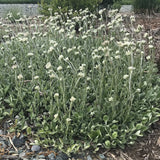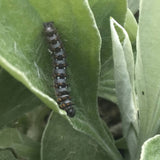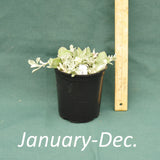Named so because its soft, felty flowers resemble the toes of a cat, pussytoes is a great wildlife plant whose flowers attract pollinators like the American painted lady butterfly, which lays its eggs on the plant’s leaves.
- Mat-forming habit with evergreen leaves
- Covers bare ground and suppresses weed growth
- Drought tolerant
Details
- 4 inches (12 inches when in flower) tall
- 12 to 48 inches wide (plants grow wider in fertile soil)
- Hardy in USDA hardiness zones 6, 7, 8, and 9
Flowering period
In central North Carolina, plants flower in mid-April.
How to grow
Pussytoes are easy to grow in most types of well-drained soil and will grow in partial shade as well as in sun.
Care and maintenance
Carefree! Though not required for the health of the plant, removing the old flowering stems (by either cutting them back by hand or running a lawnmower over them) will tidy the plant up after flowering.
Where to plant
They naturally look at home at the edge of the woods, but they also fit in at the edge of a flower bed or in front of perennials and shrubs.
When to plant
Pussytoes can be planted year-round in the South, with spring and fall being the best times for the plant and gardener.
Spacing
Around two feet apart when planting in a group.
When will my plant flower?
Plants are flowering size and will flower in the spring if purchased before March.
Native habitat and range
Antennaria plantaginifolia can be found growing along edges of dry woodland borders throughout most eastern North America.
Source and origin
Plants are grown from seeds collected at the edge of a woodland in Chatham County, NC.
| States | Orders up to $50 | Orders $51 to $100 | Orders over $100 |
| AL, DE, GA, KY, MD, NC, OH, PA, SC, TN, VA, and WV | $16 | $18 | $20 |
| AR, CT, FL, IL, IN, LA, MA, MI, MO, MS, NH, NJ, NY, RI, VT, and WI | $18 | $20 | $22 |
| IA, KS, ME, MN, OK, and TX | $20 | $22 | $24 |
| CO, NE, ND, and SD | $22 | $24 | $26 |
Sorry, we can't ship plants outside of the continental United States or to AK, AZ, CA, HI, ID, NM, NV, OR, UT, and WA due to agriculture restrictions.
When will my order be shipped?All plants are shipped within two weeks of placing an order.
Is it okay to plant in the winter?Yes, as long as the soil is not frozen. Planting native perennials in winter and early spring gives your plants a head start before the summer heat arrives.
What if it’s too cold to plant where I live, but I want to buy a plant before it sells out?Dormant plants can safely be kept in a basement, garage, or cool room until you are ready to plant in late winter or early spring.
How will my plants get delivered?Most orders are shipped on Monday or Tuesday via UPS Ground, which depending on the destination takes between 1 to 4 days.
Are your plants shipped in their containers?Yes, all our plants are shipped in their growing containers. The majority are grown in containers that are 4.5 inches wide by 5 inches deep and 32 fl. oz. / 946 ml in volume.
Do you guarantee your plants?We guarantee our plants to be healthy, ready for planting and correctly named. We are not able to guarantee whether a plant will grow in your garden as there are too many circumstances that are beyond our control.
On rare occasions, a plant shipped dormant may fail to emerge from its dormancy. If this happens, please let us know. If you are concerned about a plant, please contact us within 14 days to let us know. If we can’t help you make it grow, we’ll send you a new plant or issue a refund.
You can return your plants if you no longer want them once they arrive. To receive a refund (minus 20% restocking fee) the plants must be returned in good condition. Return shipping is the customer’s responsibility.
Can I cancel my order?Yes, you can cancel your order. Please visit our terms and service page for details.
What about sales tax?We propagate our own plants and are not required to collect North Carolina sales tax.
Where can I find information about your plants?Here are some FAQ on how we grow plants.









